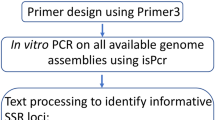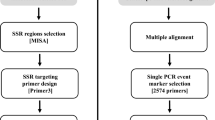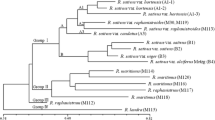Abstract
A search of nearly 2000 sequences from Solanaceae species in the EMBL and Genbank databases yielded 220 microsatellites. Among these were 80 microsatellites from 675 Lycopersicon entries. Dinucleotide repeats, as well as (CAA)n and (TAA)n repeats, were over-represented in non-coding DNA. The other trinucleotide repeats were predominantly found in exonic DNA. PCR analysis of 44 of the microsatellite-containing Lycopersicon loci identified 36 primer pairs that yielded well-scorable fragments, or groups of fragments, in L. esculentum cultivars and accessions of Lycopersicon species. Twenty-nine of these amplified bands that were polymorphic among the four Lycopersicon species. Ten primer pairs generated polymorphic bands among seven tomato cultivars. Upon examining the number of microsatellites and the degree of polymorphisms in relation to the repeat type and motif, the type of DNA the microsatellite resided in, the length of the microsatellite, and the presence of imperfections in the microsatellite, only two significant correlations were found. (i) Imperfect repeats were less polymorphic among species than perfect repeats. (ii) The percentage of loci polymorphic among cultivars increased from 6% for the shortest loci (with eight or less repeat units) to 60% for the group with the longest repeats (12 repeat units or longer). Among the species, however, all length classes contained about 83% polymorphic loci. In general, 2–4 alleles were found for each locus among the samples of the test set. In a few cases, up to eight alleles were found. A combination of these microsatellite loci can therefore be useful in distinguishing cultivars of tomato, which are genetically very closely related to each other.
Similar content being viewed by others
Author information
Authors and Affiliations
Additional information
Received: 9 August 1996 / Accepted: 23 August 1996
Rights and permissions
About this article
Cite this article
Smulders, M., Bredemeijer, G., Rus-Kortekaas, W. et al. Use of short microsatellites from database sequences to generate polymorphisms among Lycopersicon esculentum cultivars and accessions of other Lycopersicon species. Theor Appl Genet 94, 264–272 (1997). https://doi.org/10.1007/s001220050409
Issue Date:
DOI: https://doi.org/10.1007/s001220050409




